In The Lab: MSI X570 Motherboard Preview with the Godlike and Ace
by Gavin Bonshor on June 28, 2019 9:00 AM EST- Posted in
- Motherboards
- AMD
- MSI
- AM4
- Ryzen 3000
- Matisse
- X570
- X570 Godlike
- MEG
- X570 Ace
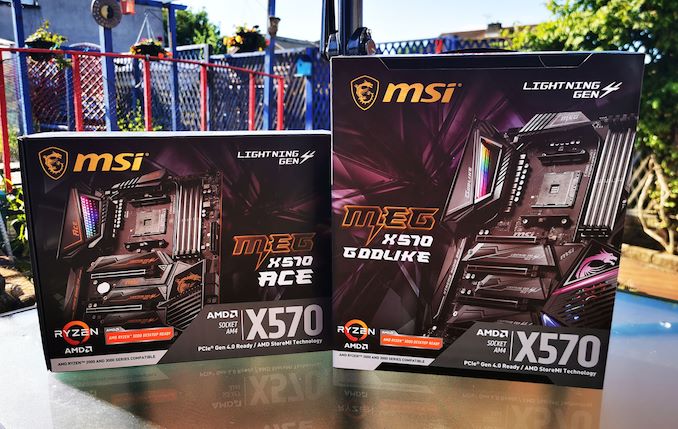
The next generation of AMD Ryzen 3000 processors is edging closer to being released, and we'll see the results on July 7th. But alongside the new 7 nm processors we have a brand new motherboard chipset. As we receive copious amounts of deliveries containing new X570 models from various vendors, the first to arrive in my hands is MSI's high-end pairing from the MEG series, the MSI MEG X570 Godlike and the MEG X570 Ace.
The Time is for X570
One of the biggest additions to AMD's AM4 socket is the introduction of the PCIe 4.0 interface. The new generation of X570 motherboards marks the first consumer motherboard chipset to feature PCIe 4.0 natively, which looks to offer users looking for even faster storage without the limitations of PCIe 3.0, and potentially better bandwidth for next-generation graphics cards over previous iterations of the current GPU architecture. We know that the current power draw of the X570 chipsets will range between 11 W and 15 W TDP. While not confirmed, it's possible that with such aggressive actively cooled heatsinks on most X570 models, that the X570 chipset potentially doesn't downclock to below 11 W, something that we aim to test.
One of the areas we intend to investigate is that there are two versions of the X570 chipset, an 11 W variant and one with a TDP of 15 W for more high-performance orientated models. This is where the actively cooled X570 heatsinks come into play to keep the chipsets cool. The difference between the two models is four PCIe 4.0 lanes.
The X570 chipset swaps out PCIe 4.0 lanes over the previous X470 and X370's use of PCIe 3.0. A big plus point to the new X570 chipset is more support for USB 3.1 Gen2 with AMD allowing motherboard manufacturers to play with 12-16 flexible PCIe 4.0 lanes and implement features how they wish. This includes 8 x PCIe 4.0 lanes, with two blocks of PCIe 4.0 x4 to play with which vendors can add SATA, PCIe 4.0 x1 slots, and even support for 3 x PCIe 4.0 NVMe M.2 slots. A modular system of allowing vendors to pick and chose different aspects of where the X570's PCIe 4.0 lanes go adds a variety of advantages for vendors to create different types of solutions based on the product's target market. For example, a vendor can select to add two sets of 4 x SATA ports for options looking to offer superior storage capabilities, with the flexible PCIe 4.0 x8 being set aside for devices such as PCIe 4.0 x4 M.2 slots. Then on top of all this, additional controllers can be added.
MSI MEG X570 Godlike: The Celestial Flagship
Starting with one of the most high-end and feature packed models from the launch day X570 product stack, the MSI MEG X570 Godlike combines a wide variety of highly premium controllers and wraps it up in a very elegant design. On the aesthetics, MSI has gone with an all-black PCB which is flanked by a black metal and plastic rear panel cover, as well as the X570 chipset heatsink which is actively cooled, but uses the Zero Frozr technology; this means that the fan has a semi-passive design which ramps up when it needs to keep the warm running X570 chipset cool. On the rear panel cover is MSI's Mystic Light Infinity II section which allows users to add their own flair of RGB infused mirror reflections to the boards aesthetic. Over on the right-hand side of the four memory slots is a Dynamic Dashboard which allows users to view the board's vital statistics including various states of system status, and more impressively, allows users to upload their own animated GIF.
Dominating the lower portion of the MSI MEG X570 Godlike's PCB is four full-length PCIe 4.0 slots which operate at x16, x8/x0/x8, and x8/x4/x4, with the last full-length slot locked down to PCIe 4.0 x4. This means both two-way NVIDIA SLI and up to four-way AMD CrossFire multi-graphics card setups can be used, with the processor driving the PCIe lanes of the top three full-length slots, while the bottom slot takes its lanes directly from the X570 chipset. In the top right-hand corner is four memory slots which are capable of supporting up to DDR4-4600 with a maximum capacity of up to 128 GB, which is dependant on the processor used. Cooling support is also impressive with a total of nine 4-pin fan headers, with a separate 4-pin header dedicated to water cooling flow which further adds to the impressive feature set on offer for MSI's X570 premier model.
Designed to push the 16 core CPU even higher, power deliveries for X570 have had to be upgraded over the previous X370 and X470 chipsets. The MSI MEG X570 Godlike is a primary example of this, and runs a 14-phase power delivery for the VCore, and a 4-phase setup for the VGT/SoC. The PWM controller of choice is the International Rectifier IR35201 which is operating in 7+1 mode, with 14 x TDA21472 70 A power stages running with 7 x IR3599 doublers. On the SoC, it's slightly different with 4 x TDA21472 70 A power stages, but with a single IR3599 doubler which looks to be splitting the PWM signal into four. Providing power to the CPU is two 8-pin 12 V ATX CPU power inputs.
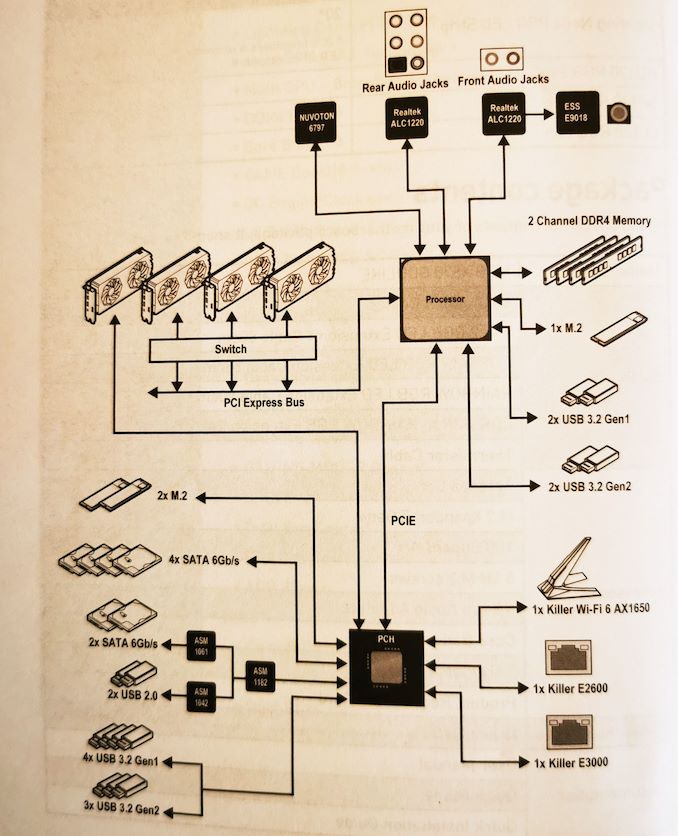
MSI MEG X570 Godlike Block Diagram
The VGT/SoC could have easily have been designed with just two phases, but there's an element of marketing strategy with vendors that more means better, which isn't always the case. We'll have to test this in the review. Cooling the power delivery is a large and robust aluminium heatsink which is interconnected via a heat pipe to the X570 chipset heatsink. Touching more on the chipset heatsink, MSI has integrated a power button, a reset switch, and MSI's Boost knob which goes all the way up to 11.
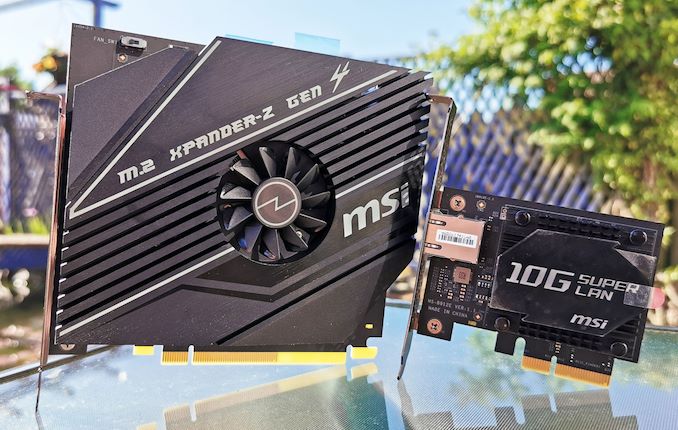
M.2 Xpander-Z Gen4 with two M.2 slots (left), Aquantia AQC107 10 G LAN Addon Card (right)
Sandwiched in between the full-length slots are three PCIe 4.0 x4 M.2 slots each with its own individual Lightning Gen4 M.2 heat shield. MSI also includes six SATA ports, and due to MSI bundling the X570 Godlike with an M.2 Xpander-Z Gen4 add-on card using its Frozr cooler, we also get an additional two PCIe 4.0 x4 M.2 drives. Another interesting inclusion is a dedicated 10 G Aquantia AQC107 NIC add-on card which gives users the choice to use either 10G, or use the integrated Killer E3000 2.5G and Killer E2600 Gigabit Ethernet ports located on the rear panel. Also featured is the Killer AX1650 Wi-Fi 6 802.11ax wireless interface which also includes support for BT 5.0 devices. This enables other features, such as offering the system using the Wi-Fi interface as an access point.
Looking closer at the rear panel of the X570 Godlike, there are three USB 3.1 Gen2 Type-A, one USB 3.1 G2 Type-C, and two USB 3.1 G1 Type-A ports. Commonly featured on premium models, the MSI MEG X570 Godlike also has a pre-installed rear panel IO shield. Also present is a Flash BIOS button with a highlighted Type-A port dedicated to firmware flashing, as well as a Clear CMOS button, and a PS/2 combo port. The onboard audio is high-end as in addition to the dual Realtek ALC1220 HD audio codecs which drive the five 3.5 mm jacks and S/PDIF optical output, MSI has included an ESS E9018 DAC for good measure, which also adds a dedicated 6.3 mm jack for studio headphones for improved compatibility out of the box. As we already touched on, the rear panel has two Ethernet ports with a Killer pairing consisting of an E3000 2.5 G, and E2600 Gigabit NIC.
What's in the Box
One of the aspects that makes the MSI MEG X570 Godlike such a premium product is the accessories bundle accompanying it. We've already touched on the M.2 Xpander-Z Gen4 add-on card which allows users to add an extra two M.2 drives to the three PCIe 4.0 M.2 slots onboard, and the additional Aquantia AQC107 10G Super LAN NIC, but there's more. Also included inside the box are six red and black braided SATA cables, a number of RGB extension cables, an antenna set for the integrated Killer AX1650 Wi-Fi 6 wireless interface, a 6.3 mm audio adapter, a user manual, with an additional quick installation guide also included for good measure.
- 6 x Red and black braided SATA cables
- RGB LED Y 80 cm extension cable
- Corsair RGB LED 50 cm extension cable
- Rainbow RGB LED 80 cm extension cable
- Corsair to Rainbow RGB 10 cm extension cable
- 2 x Thermistor cables
- Killer AX1650 antenna set
- M.2 Xpander-Z Gen4 M.2 add-on card
- 10 G Super LAN add-on card
- 3 x M.2 installation screws
- 6.3 mm audio adapter
- Case badge
- Sata cable label sheet
- Product registration card
- Driver installation disk
- User manual
- Quick Guide
- Quick installation guide
Getting hands-on with the MSI MEG X570 Godlike for the first time, one notable point is the power delivery heatsink and its design. Upon taking the board apart to do the power delivery analysis, due to the way the power delivery heatsink is connected to the chipset heatsink via a heat pipe, this meant I had to unscrew practically every screw on the rear of the board to remove it. Once removed, there's quite a bit of weight behind it so I'm confident that the cooling properties of both sets of heatsinks will be up to the mammoth task of a 14-phase CPU VCore power delivery and warm running X570 chipset. This is something we will be exploring in more detail during our review.
While MSI isn't necessarily adding anything new to its flagship models, it seems they have been listening to us in regards to networking support. On previous high-end models from MSI, they have insisted on using standard 1G NICs whereas X570 now marks a shift with the Godlike not only utilizing 1G and 2.5G NICs on the rear panel, but MSI also includes its 10 G Super LAN add-on card which uses the Aquantia AQC107 NIC which gives users a choice in which level of networking they want to use; users could even use all three if they wanted. The MSI MEG X570 Godlike is a true representation of the faith that motherboard vendors have in AMD's new 7nm Ryzen 3000 processors, and users looking for an enriched experience can look at the X570 chipset as a high-quality foundation for a high-end system. This is reflected in the boards pricing which we cannot reveal until 7/7, but we can confirm the price touted around the various media sites is wrong.
MSI MEG X570 Ace Motherboard
Moving onto the other X570 motherboard we currently have in our lab is the MSI MEG X570 Ace. As it currently stands, the X570 Ace is the entry-level to MSI's MEG branded enthusiast gaming range, but nothing about this particular board can be considered entry. This is signified with a good quality feature set with a pair of NICs, with a 2.5 Gigabit and 1 Gigabit pairing, Intel's Wi-Fi 6 802.11ac wireless interface, and 12-phase power delivery. The MSI MEG X570 Ace also follows a different design path to the rest of its launch day X570 product stack with an all-black PCB with gold and black designs on all of the heatsinks. This represents and acknowledges AMD's 50 year anniversary which although isn't specified on the packaging, certainly fits in with the gold and black color scheme. Like the flagship X570 Godlike, the X570 Ace has an MSI Mystic Light Infinity Mirror on the rear panel cover which users can customize with the Mystic Light RGB software.
In terms of PCIe, the MSI MEG X570 Ace has three full-length PCIe 4.0 slots which run at x16, x8/x8, and x8/x8/x4. The top two full-length slots run directly from the processor, while the bottom full-length slot is locked at PCIe 4.0 x4 as it takes its lanes from the X570 chipset. This allows for two-way NVIDIA SLI and up to three-way AMD CrossFire graphics card configurations to be used. Also present is two PCIe 4.0 x1 slots, with three PCIe 4.0 x4 M.2 slots which have its own individual Lightning Gen4 M.2 heat sink. Unlike a lot of other ATX sized X570 motherboards, the X570 Ace features four SATA ports with support for RAID 0, 1, and 10 arrays. For the memory, the MSI MEG X570 Ace has four memory slots with support for DDR4-4533 and up to a maximum capacity of 128 GB. Also located on the PCB is seven 4-pin fan headers, an LED Debugger located below the SATA ports, and a power button, reset switch, and an MSI Boost dial which allows users to use MSI's pre-defined overclocking profiles without entering the BIOS.
The MSI MEG X570 Ace sits in thrid position in MSI's stack; only the X570 Godlike and X570 Creation offering a bigger feature-set and better-equipped power delivery. On the MEG X570 Ace, the PWM controller of choice is the International Rectifier IR35201 which is operating in 6+2 mode with the CPU VCore element opting for 12 x IR3555 60 A power stages which are doubled up with 6 x IR3599 doublers. Providing power to the CPU is two 8-pin 12 V ATX CPU power inputs.
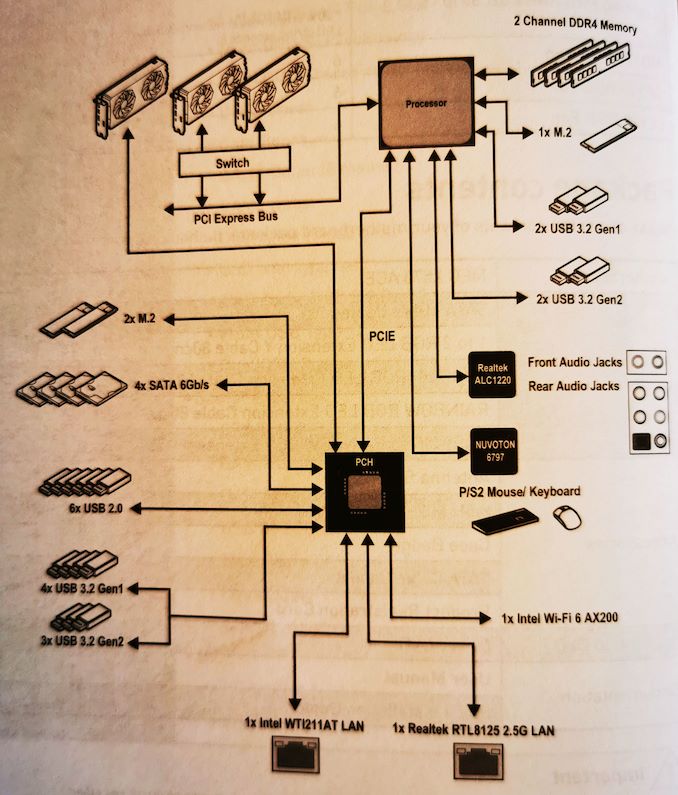
MSI MEG X570 Ace Block Diagram
The VGT/SoC is using two individual IR3555 60 A power stages to make up the 6+2 design. Keeping the power delivery cool is a large aluminium heatsink which is connected to the actively cooled X570 chipset heatsink by a single heat pipe. The X570 chipset heatsink fan is powered by MSI's Zero Frozr design which makes it semi-passive with the fan only ramping up when the chipset gets warm, and with integrated PCIe 4.0 lanes, this is sure to add extra work for the heatsink to deal with when compared with previous variants of AMD's AM4 chipsets.
Over on the rear panel, the MSI MEG X570 Ace is three USB 3.1 G2 Type-A, a single USB 3.1 G2 Type-C, two USB 3.1 G1 Type-A, and two USB 2.0 ports. Onboard audio wise, there are five 3.5 mm audio jacks and a S/PDIF optical output powered by a Realtek ALC1220 HD audio codec, while the two Ethernet ports are each controlled by a Realtek RTL8125-CG 2.5 G and Intel I211-AT Gigabit pairing of NICs. The X570 Ace also includes a Realtek AX1650 Wi-Fi 6 802.11ax wireless interface which also adds BT 5.0 connectivity to the board. Also featured on the rear panel is a Clear CMOS button, a BIOS Flashback switch with a highlighted USB Type-A port for users to update the firmware, and a PS/2 combo keyboard and mouse port. As with other premium X570 models from MSI, the X570 Ace also benefits from a pre-installed IO shield.
What's in the Box
Included within the accessories bundle for the MSI MEG X570 Ace are four SATA cables, four RGB extension cables, an antenna set for the Realtek AX1650 802.11ax Wi-Fi 6 wireless interface, three M.2 installation screws, a driver installation disc, and a user manual. Although not as jam-packed as the X570 Godlike's bundle, the X570 Ace certainly provides everything needed to get a system up and running out of the box, and one area which we will look at in the final review will include the software bundle, which is an area MSI usually load up on.
- 4 x SATA cables
- RGB LED Y 80 cm extension cable
- Corsair RGB LED 50 cm extension cable
- Rainbow RGB LED 80 cm extension cable
- Corsair to Rainbow RGB 10 cm extension cable
- Killer AX1650 antenna set
- 3 x M.2 installation screws
- Case badge
- Sata cable label sheet
- Product registration card
- Driver installation disc
- User manual
- Quick installation guide
Like with the MSI MEG X570 Godlike, the MEG X570 Ace does include a fair amount of plastic on the rear panel cover and around the X570 chipset heatsink. this is more forgivable on a non-flagship model such as this, and although it shouldn't affect thermal performance due to the actively cooled chipset heatsink, metal would give a more premium feel.
As previously mentioned, the MSI MEG X570 Ace sits as number three in its product stack in terms of features behind the MEG X570 Godlike and Prestige X570 Creation. The MEG X570 Ace has a good mixture of high-quality features such as a complete offering of Realtek controllers covering the wired and wireless networking capabilities, as well as the onboard audio. With confirmed support for 32 GB UDIMMs, users can use a Ryzen 3000 series processor with up to 128 GB of system memory which is good to see, and with a 2.5 Gigabit Ethernet port and Wi-Fi 6 capability on the rear panel, it's nice to see MSI focusing more on offering comprehensive product without sacrificing the price to performance ratio with common Gigabit NIC on its high-end models.
The embargo for performance details on these motherboards is on July 7th.
Update: Amazon UK currently has the MSI MEG X570 Godlike listed available for pre-order for launch day on 7/7
Related Reading
- AMD Reveals the X570 Chipset: PCIe 4.0 is Here
- ASRock X570 Aqua: Heaviest AMD Flagship Motherboard Ever (Plus Thunderbolt)
- The MSI Prestige X570 Creation Motherboard: 10G LAN, PCIe 4.0 M.2 Xpander, USB 3.1 Gen2 King
- AMD 16-Core Ryzen 9 3950X: Up to 4.7 GHz, 105W, Coming September
- AMD Ryzen 3000 Announced: Five CPUs, 12 Cores for $499, Up to 4.6 GHz, PCIe 4.0, Coming 7/7


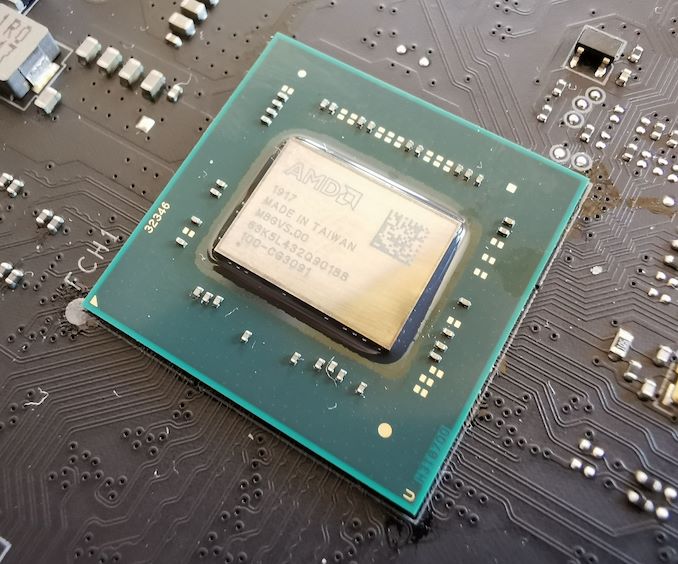
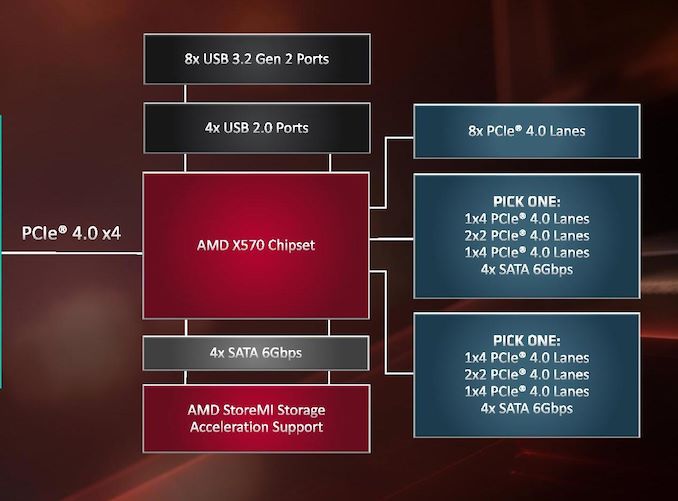
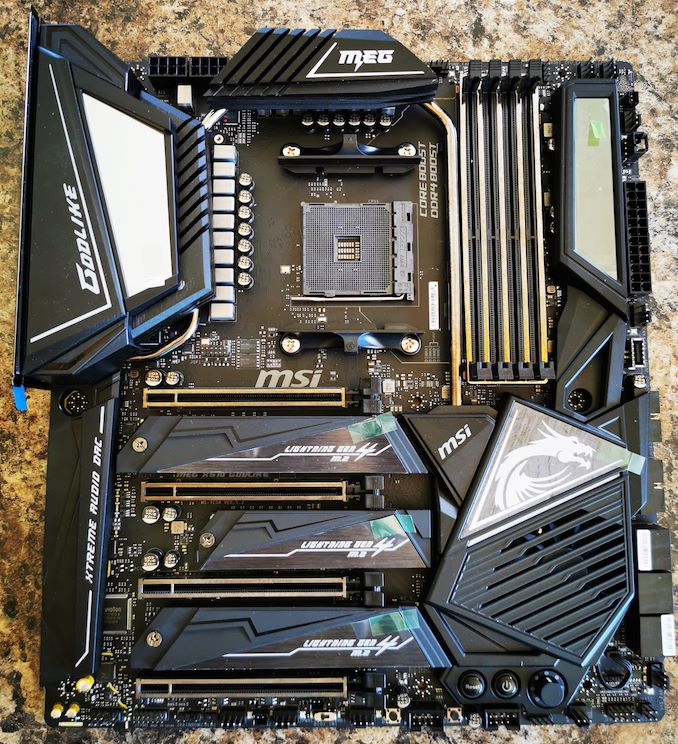


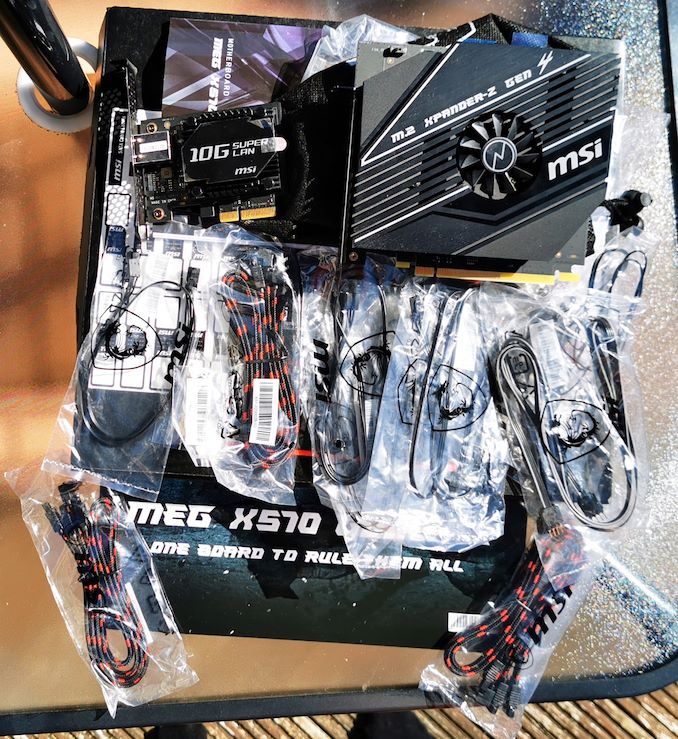
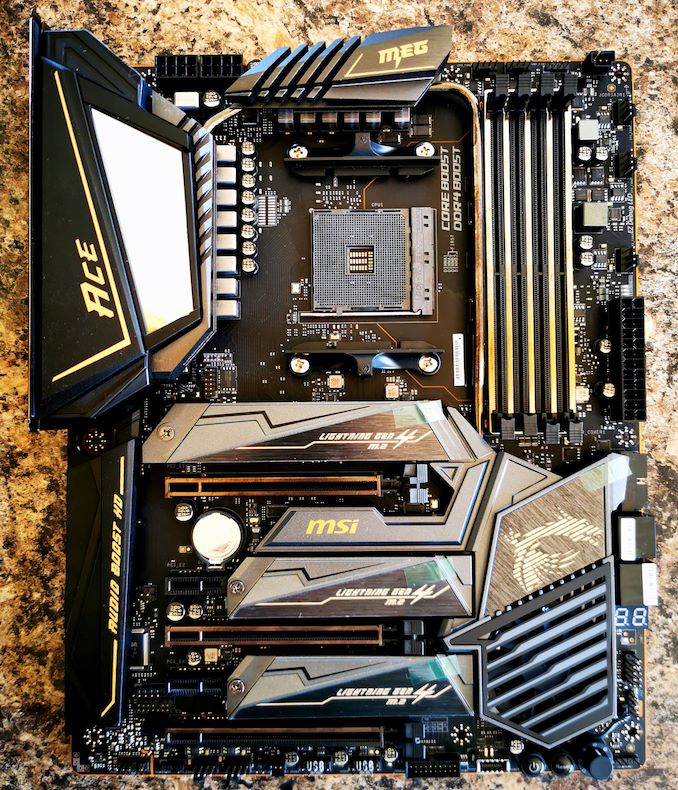
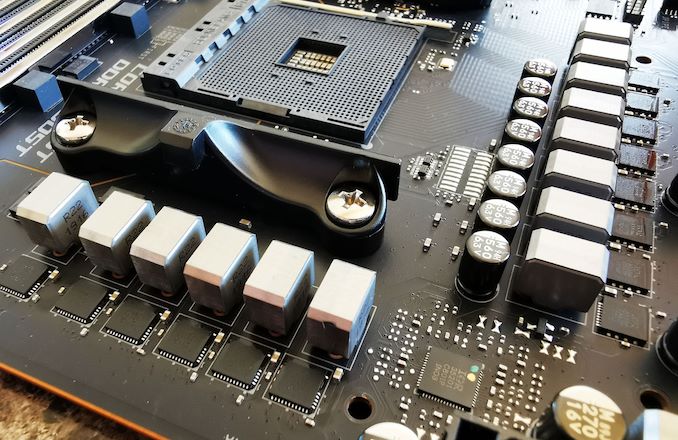
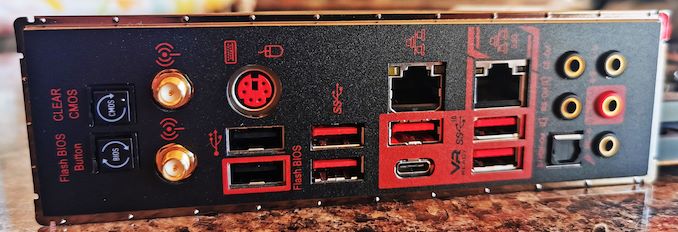
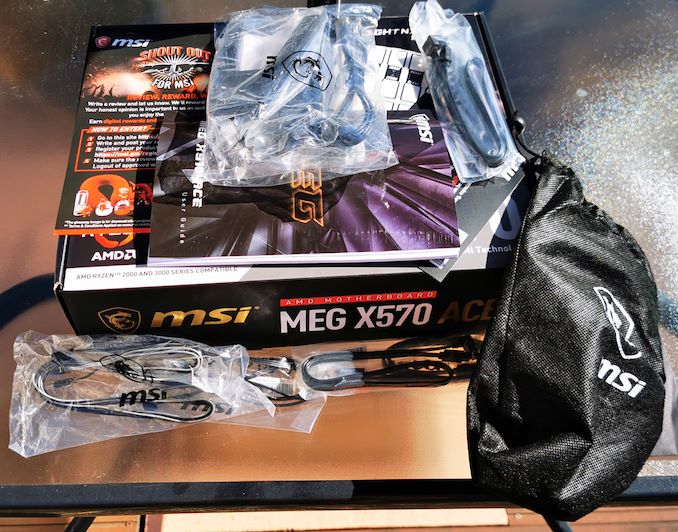
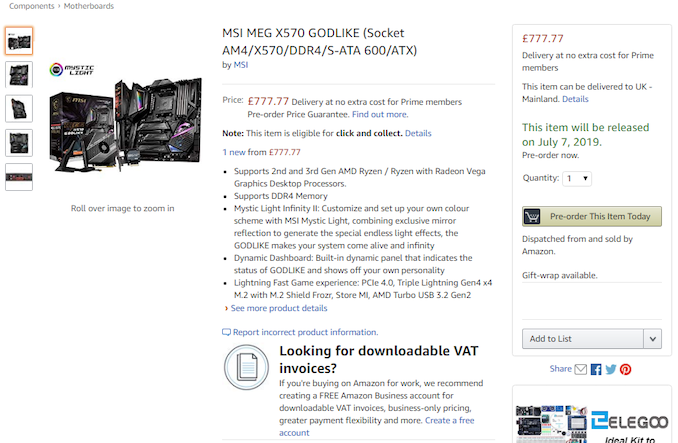








87 Comments
View All Comments
Death666Angel - Friday, June 28, 2019 - link
Thanks for that! Any mATX variants on the way? :D Or is it just the AsRock Pro4? Would be more than we had X470 mATX motherboards.plonk420 - Friday, June 28, 2019 - link
THANK YOU for including VRMs! i don't even OC and i'm eyeing them closely. hopefully, it'll lead to a board that will live waaaay too ridiculously longlevizx - Friday, June 28, 2019 - link
I don't understand how this works. The CPU and X570 are linked by PCIe 4.0 x4, but the X570 then provides roughly PCIe 4.0 x20 worth of I/O?Hul8 - Friday, June 28, 2019 - link
Ryzen 3000 CPUs themselves will have total of 24 PCIe 4.0 lanes: x4 of which to the chipset and x4 to the primary M.2 slot. The remaining x16 are usually routed to the primary and secondary expansion slots, to be used in either x16/x0 or x8/x8 configuration, although motherboards can arrange these in other ways too.Modern chipsets are essentially PCIe hubs. The X570 is connected the the CPU using PCIe 4.0 x4 (around 8 GB/s) and splits this into more connections. The total bandwidth is limited by the uplink, but since you'll want to connect your most bandwidth-hungry devices directly to the CPU, it's really not an issue for most people.
levizx - Saturday, June 29, 2019 - link
Yea, but what's the point of supporting x8 link?TheUnhandledException - Saturday, June 29, 2019 - link
Yeah that is exactly how every PCIe lanes off every chipset for the past decade or so has worked. The 300 series Ryzen have 24 native PCIe lanes. 16 for GPU, 4 for m.2 and 4 to connect to the chipset. The chipest then shares those for 20 PCIe worth of "stuff". Every other AMD and Intel CPU and chipset combo has worked exactly the same way except with PCIe 3 lanes not PCIe 4 lanes.levizx - Saturday, June 29, 2019 - link
I simply don't understand what's the point of having x8? Sure 2 or more x4 links can share one x4 upstream, but how do you do that with x8?TheUnhandledException - Saturday, June 29, 2019 - link
It is 8 lanes not necessarily a single x8 slot. So it could be configured by the OEM as a pair of x4 or two x1 an x4 and using the other 2 lanes for additional onboard stuff (2.5, 5, or 10 Gb ethernet, TB3, etc).Death666Angel - Saturday, June 29, 2019 - link
The general idea is that nothing ever gets used at the same time. Also, SLI has an x8 requirement, so even if it is a bottleneck x4 slot in the end, SLI would still work without registry or driver hacks. But I doubt many motherboards will have an x8 slot from the chipset. Some might, but not a lot.Hul8 - Monday, July 1, 2019 - link
Consider that it will take a long time before devices support PCIe 4. In the meantime, you'll need PCIe 3 x8 or PCIe 2 x16 to saturate the 8 GB/s PCIe 4 x4 uplink.Having said that, I think x8 on the chipset is unpractical in general purpose PCs for GPUs for latency reasons, and for anything for consuming too much of the connectivity.
The x16 and x8 options may have been included simply because the silicon can do it - the X570 chipset design is repurposed from the Ryzen 3000 CPU I/O die design.
Who knows, maybe a motherboard or system manufacturer comes up with a special case where using up 8 lanes for a device makes sense?